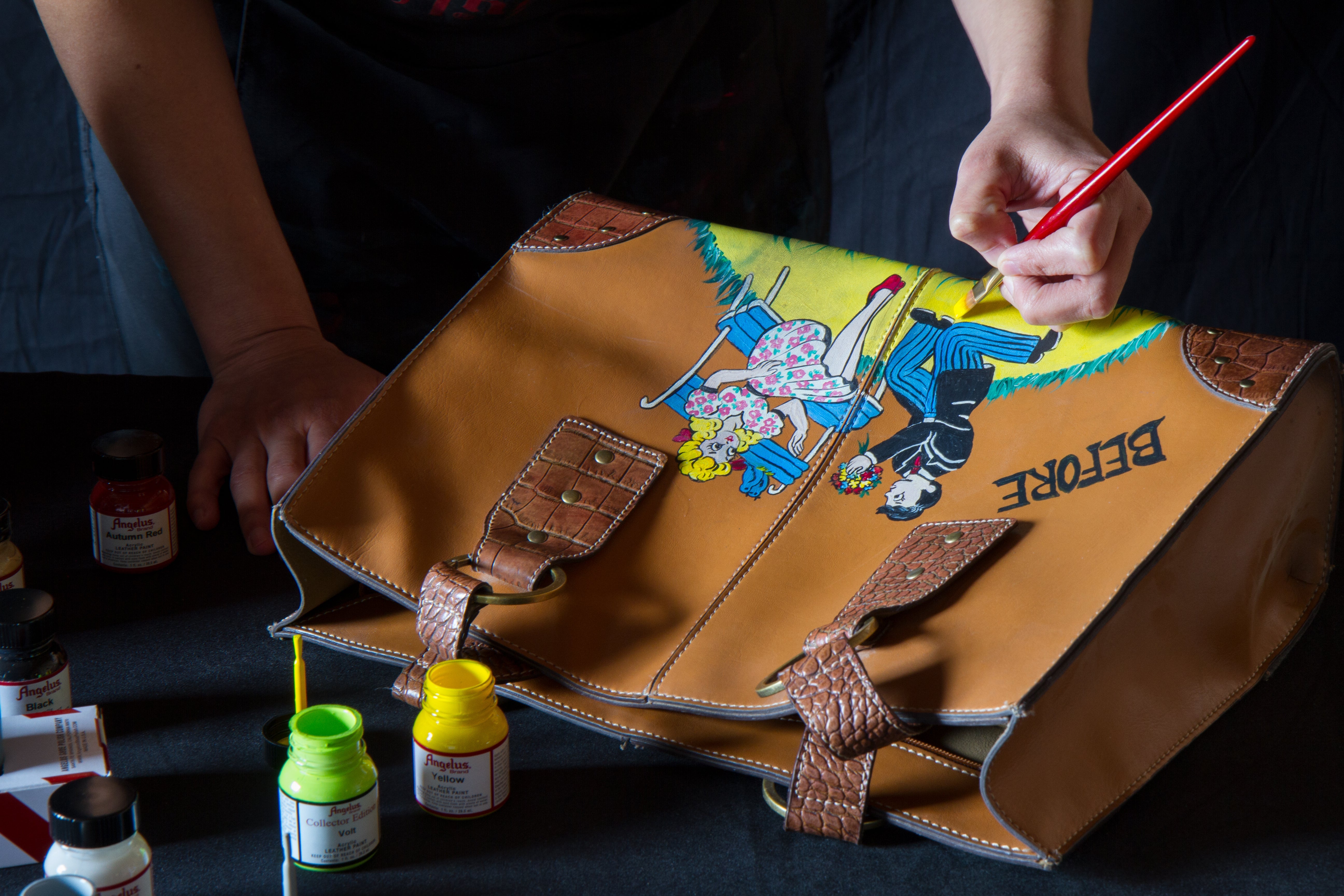Leather bag customization has become increasingly popular as more people seek to express their individuality through unique designs and colors. Whether you’re a seasoned artist or a DIY enthusiast, painting leather bags can be a rewarding and creative experience. Using the right materials and techniques is crucial for achieving professional results and ensuring the longevity of your artwork.
This comprehensive guide will walk you through everything you need to know about painting leather bags, from understanding different types of leather paints to step-by-step instructions on how to apply them. By the end of this article, you’ll have all the knowledge you need to transform any leather bag into a stunning piece of art.
Understanding Leather Paints

Before diving into the painting process, it’s important to understand the different types of leather paints available and their respective advantages and disadvantages. This knowledge will help you choose the best paint for your project and ensure a high-quality finish.
Types of Leather Paints
Acrylic Leather Paints
Acrylic leather paints are water-based and are the most commonly used paints for leather projects. They are known for their vibrant colors, ease of use, and quick drying times. These paints can be mixed to create custom shades, making them highly versatile for various designs.
Recommended Brands
For the best results, it’s important to use high-quality paints. Angelus Direct is a well-known and trusted brand that offers a wide range of leather paints, sealants, and other materials needed for leather customization. Our products are specifically designed for use on leather and are highly regarded by both professionals and hobbyists.
Preparation Before Painting

Proper preparation is key to achieving a smooth and long-lasting finish on your leather bag. This section covers how to choose the right leather bag, clean and prepare the surface, and create a design plan.
Choosing the Right Leather Bag
Not all leather is created equal, and some types are better suited for painting than others. Smooth, untreated leather is ideal for painting as it allows the paint to adhere properly. Avoid heavily textured, waxed, or finished leathers, as these surfaces can be difficult to paint on and may not hold the paint well.
Cleaning and Preparing the Leather Surface
A clean surface is essential for proper paint adhesion. Any dirt, oils, or residues can prevent the paint from sticking and result in a poor finish.
Cleaning Solutions and Tools
Use a mild soap and water solution or a specialized leather cleaner to clean the surface of the bag. Avoid harsh chemicals that can damage the leather. You will also need a soft cloth or sponge for cleaning.
Techniques for Cleaning
Gently wipe down the surface of the leather bag with the cleaning solution and a soft cloth or brush. Make sure to remove all dirt and oils. Allow the leather to dry completely before moving on to the next step. Next, Leather Preparer or Deglazer can be used, but be sure to follow the manufacturer’s instructions carefully.
Creating a Design Plan
Having a clear design plan is crucial for a successful painting project. This involves sketching your design and choosing the right colors and tools.
Sketching the Design
Before applying paint to your leather bag, sketch your design on paper. This helps you visualize the final result and make any necessary adjustments. You can use a paint marker or chalk to lightly sketch the design directly onto the leather as well.
Choosing Colors and Tools
Select colors that complement your design and the leather bag. Gather all the necessary tools, including brushes, sponges, stencils, and any other accessories you might need. Having everything ready will make the painting process smoother and more enjoyable.
Tools and Materials Needed
To achieve professional results, it’s important to use the right tools and materials. This section outlines the essential tools and materials you’ll need for your leather painting project.
Essential Tools for Leather Painting
Brushes
Different sizes of brushes are essential for various aspects of the painting process. Fine brushes are perfect for detailed work, while larger brushes are ideal for applying base coats.
Sponges
Sponges are great for applying base coats evenly and can also be used to create interesting textures.
Airbrushes
An airbrush can provide a smooth, even coverage and is ideal for larger areas or creating gradients. It’s a useful tool for achieving a professional finish.
Must-Have Materials
Paints
High-quality leather paints are crucial for a durable and vibrant finish. Ensure you have the right type and colors for your project.
Sealants
Sealants protect your design and extend the life of your painted leather bag. Choose a sealant that matches the type of paint you’re using.
Primers and Conditioners
Primers help the paint adhere better to the leather, while conditioners keep the leather supple and prevent it from drying out.
Additional Accessories
Tape and Stencils
Tape and stencils are useful for creating precise lines and shapes. They can help you achieve a more polished and professional look.
Gloves and Aprons
Protective gear like gloves and aprons will keep your hands and clothes clean while you work.
Step-by-Step Guide to Painting Leather Bags

This step-by-step guide will take you through the entire process of painting a leather bag, from setting up your workspace to sealing your finished design.
Preparing the Work Area
A clean, well-organized workspace is essential for a successful painting project.
Setting Up a Clean Workspace
Ensure your work area is clean and free of dust. A well-lit space will help you see your work clearly and ensure even application of paint.
Protecting Surrounding Areas
Use drop cloths or old newspapers to protect surrounding surfaces from paint splatters. This will make cleanup easier and prevent accidental damage.
Applying the Base Coat
The base coat is the foundation of your design and should be applied carefully for a smooth finish.
Techniques for Smooth Application
Apply thin, even layers of paint using a brush or sponge. Avoid overloading the brush to prevent drips and uneven coverage.
Drying Time and Tips
Allow each layer of paint to dry completely before applying additional coats. This prevents cracking and ensures a smooth, even finish. Use a hairdryer on a low setting to speed up the drying process if needed.
Adding Details and Designs
Once the base coat is dry, you can start adding details and designs to your leather bag.
Using Brushes and Sponges for Detail Work
Fine brushes are perfect for intricate designs, while sponges can create interesting textures. Use steady, controlled strokes to achieve clean lines and precise details.
Techniques for Blending and Shading
Blending and shading add depth and dimension to your design. Apply lighter and darker shades while the paint is still wet and blend using a soft brush or sponge. Practice these techniques on a scrap piece of leather before applying them to your bag.
Sealing and Protecting the Paint
Sealing your painted leather bag is crucial for protecting your design and ensuring it lasts.
Types of Finishers
There are various types of sealants available, including flat, matte, satin, and glossy finishes. Choose a sealant that complements your design and provides the desired level of protection.
Application Techniques
Apply sealant in thin, even coats using a brush or sponge. Allow each layer to dry completely before applying the next. Be sure to cover all painted areas to ensure complete protection.
Ensuring Long-Lasting Results
Properly sealed paint will withstand wear and tear, keeping your design looking fresh and vibrant. Regularly inspect your bag for signs of wear and reapply sealant as needed.
Tips and Tricks for Best Results
Achieving the best results requires attention to detail and a few insider tips.
Avoiding Common Mistakes
Overloading the Brush
Using too much paint on your brush can result in drips and uneven coverage. Always apply thin, even layers and build up the color gradually.
Skipping Preparation Steps
Proper preparation is crucial for a successful project. Don’t skip cleaning and prepping the leather, as these steps ensure the paint adheres properly and lasts longer.
Advanced Techniques
Using an Airbrush for Smooth Finishes
An airbrush provides a smooth, even finish and is ideal for large areas or intricate designs. Practice using the airbrush on a scrap piece of leather before applying it to your bag.
Layering and Blending Colors
Layering and blending colors can create depth and dimension in your design. Apply lighter and darker shades while the paint is still wet and blend using a soft brush or sponge.
Maintaining Your Painted Leather Bag
Proper maintenance will keep your painted leather bag looking great for years to come.
Cleaning and Care Tips
Wipe down your bag with a damp cloth to remove dirt and dust. Avoid using harsh chemicals that can damage the paint. Store your bag in a cool, dry place away from direct sunlight to prevent fading.
Touching Up Scratches and Fades
Keep leftover paint for touch-ups as needed. Lightly sand the area around the scratch or fade and apply a thin layer of paint, blending it into the surrounding area.
Creative Ideas and Inspirations
Looking for inspiration? Here are some creative ideas and design trends to get you started.
Popular Design Trends
Minimalist Designs
Minimalist designs feature clean lines and simple color schemes. They are perfect for creating a sophisticated and modern look.
Floral Patterns
Floral patterns add a touch of elegance and femininity to your leather bag. Use stencils or freehand painting to create delicate flowers and leaves.
Geometric Shapes
Geometric shapes are bold and modern. Use tape and stencils to create precise lines and shapes for a striking design.
Painting leather bags is a fun and creative way to personalize your accessories. With the right preparation, quality paints, and proper sealing, your designs can remain vibrant and long-lasting. Angelus Direct provides premium leather paints and sealants, ensuring a professional finish while keeping the leather soft and durable.
By experimenting with colors and techniques, you can create unique, customized pieces that reflect your style. Whether you're a beginner or experienced artist, practice and creativity are key to mastering leather customization. Enjoy the process, embrace your creativity, and turn your leather bag into a true work of art!
Frequently Asked Questions
What type of leather bag is best for painting?
Smooth, untreated leather is ideal for painting as it allows the paint to adhere properly. Avoid heavily textured, waxed, or finished leathers.
How do I prevent the paint from cracking or peeling on my leather bag?
Apply thin, even layers of paint and allow each coat to dry completely. Properly sealing your painted bag will also help protect the paint and prevent cracking or peeling.
Can I repaint over an old design on a leather bag?
Yes, lightly sand the surface to remove any loose paint, clean the area thoroughly, and apply a new base coat before adding your new design.

